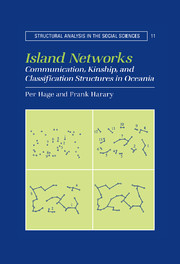Preface
Published online by Cambridge University Press: 06 August 2010
Summary
This book is the third work in a comprehensive program of research on applications of graph theory to anthropology. Graph theory is an explosively developing branch of pure mathematics with increasingly important applications to many fields, including architecture, biology, chemistry, computer science, cognitive science, economics, geography, and operations research. It is our belief that anthropology belongs with this company of subjects. Our aims are (1) to solve certain theoretical and methodological problems in anthropology by using the concepts, theorems, and techniques of graph theory; (2) to provide a common framework for structural analysis by demonstrating the applicability of graph theory to a wide spectrum of social and cultural phenomena; (3) to promote connections between various areas of anthropology and between anthropology and other disciplines in which graph theoretic modeling has proven useful; (4) to preserve continuity with the historical tradition of structural analysis in anthropology; and (5) to make graph theoretic models accessible to all structurally minded anthropologists and other social scientists.
In our first book, Structural Models in Anthropology (Hage and Harary 1983), we presented graph theory as a family of models for the analysis of social, symbolic, and cognitive relations. We used graphs, digraphs, and networks, together with their associated matrices, to study such diverse topics as mediation and power in exchange systems, reachability in social networks, efficiency in cognitive schemata, and productivity in subsistence modes. We exploited duality laws for graphs and the interaction between graphs and groups to analyze transformations and permutations in myths and symbolic systems.
- Type
- Chapter
- Information
- Island NetworksCommunication, Kinship, and Classification Structures in Oceania, pp. xv - xviiiPublisher: Cambridge University PressPrint publication year: 1996



